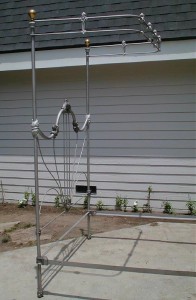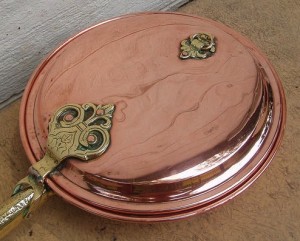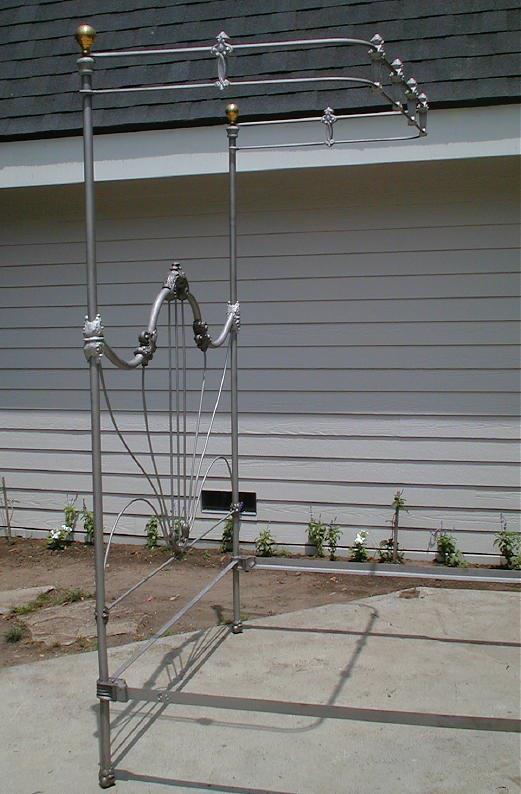 A “half tester” is a form of canopy. The manner in which it differs from traditional “four poster” canopies is that it is only attached to the headboard…..not the foot-board. So why, you ask yourself, would someone want a canopy just at the headboard and not at the foot-board, where it would encompass the entire perimeter of the mattress. Good question.
A “half tester” is a form of canopy. The manner in which it differs from traditional “four poster” canopies is that it is only attached to the headboard…..not the foot-board. So why, you ask yourself, would someone want a canopy just at the headboard and not at the foot-board, where it would encompass the entire perimeter of the mattress. Good question.
The easiest way to understand a “half tester” is first to get a feel for what it looks like. Take a look at the photo on this blog. You’ll see canopy poles just on the headboard. On the top of those poles are attached canopy rods, that normally would go the entire length and width of the bed. In the case of the “half tester”, those rods do go the entire width of the bed. But the the rods that would normally go the entire length, only come out approximately 2′ from the headboard and then curve at a right angle and continue across the width of the mattress and then back to meet the headboard canopy poles.
To get back to the practicality of “half tester” canopy, you first have to know the purpose of a full canopy. Many people today don’t know the origin of the canopy or it’s practical use and only think it is an attractive design element. When canopies were first used, they served three very practical purpose.
The first : Retention of heat. Interior heat back in the late 1700’s and early 1800’s was not what it is today. Home’s and castles were heated by fireplaces, that were not the most efficient way to heat a home. Homes were also not insulated as they are today and often the only thing between the outside paneling and the inside, was a coat of paint.  At night the fires would usually loose a lot of their heat because no one was continually putting wood on the fire. People would do what they call “banking” a fire. So the wood was placed in such a position not to burn so fast, yet maintain a degree of fire and warmth. The canopy top on a bed was always covered with material and then curtain’s hung down from all four sides giving an enclosed tent effect. This enclosed “cocoon” helped retain the occupants body heat and any other then used heat sources like copper bed warmers. I have a photo of one here. They were on a long stick, enabling the person to position it between the springs and mattress. Inside it were placed hot coals from the fire. These coals would burn all night and give off heat through the mattress. The canopy would also help to retain this heat.
At night the fires would usually loose a lot of their heat because no one was continually putting wood on the fire. People would do what they call “banking” a fire. So the wood was placed in such a position not to burn so fast, yet maintain a degree of fire and warmth. The canopy top on a bed was always covered with material and then curtain’s hung down from all four sides giving an enclosed tent effect. This enclosed “cocoon” helped retain the occupants body heat and any other then used heat sources like copper bed warmers. I have a photo of one here. They were on a long stick, enabling the person to position it between the springs and mattress. Inside it were placed hot coals from the fire. These coals would burn all night and give off heat through the mattress. The canopy would also help to retain this heat.
The second: In the very old days many of the cottages in England were constructed with sod roofs and some with thatched roofs made of straw. A roof of this nature was far from being weather tight. It also was constantly being dug into by rodents looking for a warm place to sleep. When they would burrow through the sod, it was not uncommon for them to fall on top of the occupants of the bed. A strong material cover over the top of the canopy poles would prevent the rodents from ending up in bed with the owners of the house.
The third: In merry old England and throughout the countryside, castles often were built with a single great room that not only the lords of the manor would sleep in, but also all the field hands. They usually positioned themselves at either ends of the great room. The owner of the castle would usually be the only one with a conventional bed frame. The workers would sleep on sleeping mats on the floor. The full canopy provided the lord of the castle with some degree of privacy for him and his wife.
These three things were also present on “half tester” beds…… but in a slightly modified manner. The top, sides, and back were covered with curtains to retain the heat as was the full canopy. But in the instance of a “half tester”, the curtains that were usually at the end of the bed would now drape down around the waist of the occupant in the bed. One of the only benefits of a “half tester” was that the space to be heated was only half the volume of a bed with a full canopy. There were few other benefits, which is why they weren’t more prevalent .
I hope you’ve found this blog informative . I invite you to revisit my website
to answer any and all questions you might have about antique iron beds.
I also invite you to take a look at our company Face Book page for multiple photo albums on a wide variety of Iron Beds, Custom Finishes, Canopy Conversions and a comprehensive “Before & After” King Conversions album.
https://www.facebook.com/pages/Cathouse-Antique-Iron-Beds/126838177398







